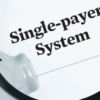Excerpt:
During the current healthcare debates that continue to occupy the majority of media attention in this country, many solutions have been tossed around. The NEJM panel discusses cost control and the need to balance it with achieving an ultimate goal of universal coverage. Many cost control ideas are tossed around in the discussion, with varying impacts considered. One in particular, is the framework of a Single-Payer system. While the NEJM round table gives a broad overview, this analysis will drill down further.
Single-Payer (SP for further reference) is a financing approach that is similar in structure to Medicare. As the name implies, there is one institution that collects health care fees from individuals and purchasers. It also pays out all health care cost reimbursements to providers and suppliers. Of the four actors of health care (purchasers, insurers, providers and suppliers), the missing participant is private insurers. Instead, there is only one main government insurer system at a federal or state level.





